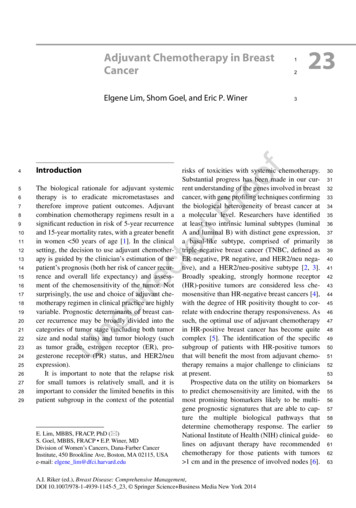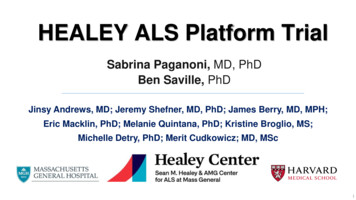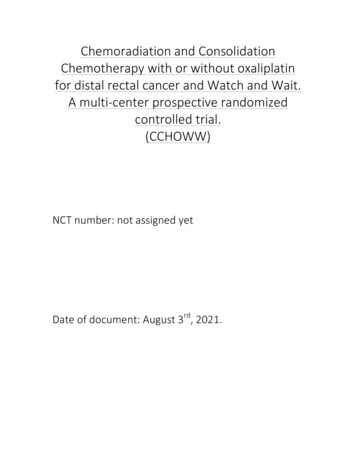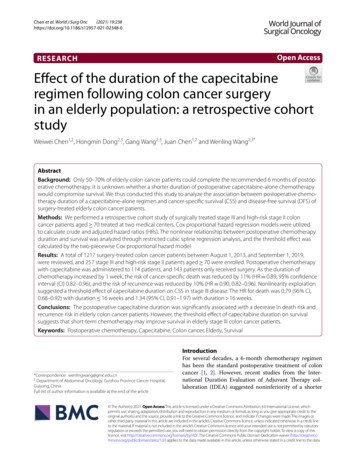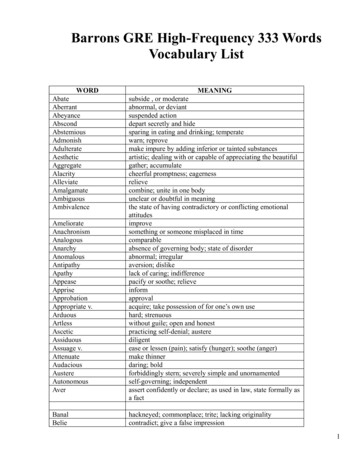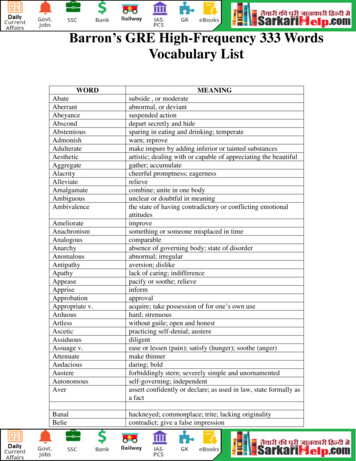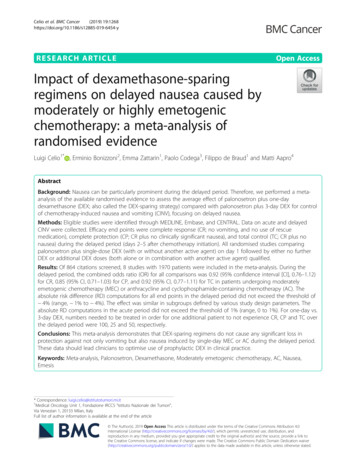
Transcription
Celio et al. BMC Cancer(2019) SEARCH ARTICLEOpen AccessImpact of dexamethasone-sparingregimens on delayed nausea caused bymoderately or highly emetogenicchemotherapy: a meta-analysis ofrandomised evidenceLuigi Celio1* , Erminio Bonizzoni2, Emma Zattarin1, Paolo Codega3, Filippo de Braud1 and Matti Aapro4AbstractBackground: Nausea can be particularly prominent during the delayed period. Therefore, we performed a metaanalysis of the available randomised evidence to assess the average effect of palonosetron plus one-daydexamethasone (DEX; also called the DEX-sparing strategy) compared with palonosetron plus 3-day DEX for controlof chemotherapy-induced nausea and vomiting (CINV), focusing on delayed nausea.Methods: Eligible studies were identified through MEDLINE, Embase, and CENTRAL. Data on acute and delayedCINV were collected. Efficacy end points were complete response (CR; no vomiting, and no use of rescuemedication), complete protection (CP; CR plus no clinically significant nausea), and total control (TC; CR plus nonausea) during the delayed period (days 2–5 after chemotherapy initiation). All randomised studies comparingpalonosetron plus single-dose DEX (with or without another active agent) on day 1 followed by either no furtherDEX or additional DEX doses (both alone or in combination with another active agent) qualified.Results: Of 864 citations screened, 8 studies with 1970 patients were included in the meta-analysis. During thedelayed period, the combined odds ratio (OR) for all comparisons was 0.92 (95% confidence interval [CI], 0.76–1.12)for CR, 0.85 (95% CI, 0.71–1.03) for CP, and 0.92 (95% CI, 0.77–1.11) for TC in patients undergoing moderatelyemetogenic chemotherapy (MEC) or anthracycline and cyclophosphamide-containing chemotherapy (AC). Theabsolute risk difference (RD) computations for all end points in the delayed period did not exceed the threshold of 4% (range, 1% to 4%). The effect was similar in subgroups defined by various study design parameters. Theabsolute RD computations in the acute period did not exceed the threshold of 1% (range, 0 to 1%). For one-day vs.3-day DEX, numbers needed to be treated in order for one additional patient to not experience CR, CP and TC overthe delayed period were 100, 25 and 50, respectively.Conclusions: This meta-analysis demonstrates that DEX-sparing regimens do not cause any significant loss inprotection against not only vomiting but also nausea induced by single-day MEC or AC during the delayed period.These data should lead clinicians to optimise use of prophylactic DEX in clinical practice.Keywords: Meta-analysis, Palonosetron, Dexamethasone, Moderately emetogenic chemotherapy, AC, Nausea,Emesis* Correspondence: luigi.celio@istitutotumori.mi.it1Medical Oncology Unit 1, Fondazione IRCCS “Istituto Nazionale dei Tumori”,Via Venezian 1, 20133 Milan, ItalyFull list of author information is available at the end of the article The Author(s). 2019 Open Access This article is distributed under the terms of the Creative Commons Attribution 4.0International License (http://creativecommons.org/licenses/by/4.0/), which permits unrestricted use, distribution, andreproduction in any medium, provided you give appropriate credit to the original author(s) and the source, provide a link tothe Creative Commons license, and indicate if changes were made. The Creative Commons Public Domain Dedication o/1.0/) applies to the data made available in this article, unless otherwise stated.
Celio et al. BMC Cancer(2019) 19:1268BackgroundChemotherapy-induced nausea and vomiting (CINV) remain among the most common disturbing side effects ofcancer chemotherapy [1, 2]. CINV is typically categorizedas acute (within the first 24 h after chemotherapy initiation) and delayed (starts on day 2 and can have a timespan of up to 6–7 days). In the last two decades, betterprevention of CINV has been the result of several steps including the development of new classes of anti-emetics,such as 5-hydroxytryptamine type 3 receptor antagonists(5-HT3RAs) and neurokinin-1 receptor antagonists (NK1RAs) [3]. Nevertheless, dexamethasone (DEX), one of thefirst antiemetic drug to be introduced, remains used extensively in multi-drug regimens recommended for theprevention of acute and delayed CINV caused by highly ormoderately emetogenic chemotherapy (HEC and MEC,respectively) [4, 5]. Although prophylactic DEX has beengenerally considered safe, its administration may be associated with a wide range of side effects [6]. In a prospective survey patients receiving a multiple-day DEX regimenagainst delayed CINV caused by MEC reported severalmoderate-to-severe DEX-related side effects, including insomnia, abdominal symptoms, agitation, weight gain, skinrash and other symptoms in the week following chemotherapy [7]. Therefore, there is interest in minimising doseand frequency of the steroid, particularly in those patientswho experience DEX-related side effects or in those withpre-existing conditions (like diabetes) that may be exacerbated by corticosteroids.Palonosetron is a “second-generation” 5-HT3RA with alonger half-life ( 40 h) and distinct pharmacological properties compared with older agents in the 5-HT3RA class[8]. The unique pharmacology of palonosetron has beenthought to partly explain its improved efficacy against delayed CINV [9]. Two randomised trials challenged the hypothesis that palonosetron plus single-dose DEX, alsocalled the DEX-sparing strategy, is not inferior to palonosetron plus 3-day DEX against CINV caused by MEC [10,11]. These studies met their goal, but the study by Aaproet al. [10] included only breast cancer patients receiving thecombination of an anthracycline and cyclophosphamide(AC), whereas the study by Celio et al. [11] included a widerange of MEC regimens including AC. At the time thestudies were performed AC was considered as MEC, andonly successively classified as HEC, for which the additionof an NK-1RA is recommended for CINV control [4, 5].The international guidelines have recently changed theanti-emetic management of AC-type chemotherapy in female patients and of MEC, and no longer recommend DEXfor the prevention of delayed CINV, except for agents withknown potential for delayed symptoms [4, 5]. Interestingly,this recommendation stems from the lack of convincingevidence to support the benefit of DEX against delayedCINV caused by AC or MEC, before a formal meta-Page 2 of 13analysis. An important consideration when evaluating datafrom the first DEX-sparing trials is that, although any potentially detrimental effect on antiemetic protection wouldbe expected to occur during the delayed period, the studies used data from the overall observation period (i.e.,acute plus delayed periods) to calculate the primary efficacy outcome of complete response (CR) [10, 11]. It is alsoimportant to highlight that CR is a composite end pointthat does not include any direct assessment of nauseawhose optimal control still remains a treatment challenge[12]. Therefore, there were several important questionsunanswered regarding the exact therapeutic impact of theDEX-sparing strategy on the management of CINV. Specifically, how effective is the DEX-sparing strategy compared with a multiple-day DEX regimen against delayedCINV? Is the effect different when control of nausea isassessed? What evidence exists for the efficacy of DEXsparing strategy when combined with other active agents?Is there evidence of variability in the reported protectiveeffect in patients receiving HEC or MEC? Finally, is thereevidence of any distinct tolerability profile of the DEXsparing strategy? In order to help answer these questions,we report the results of a systematic review and metaanalysis of randomised controlled trials (RCTs) addressingthe efficacy of DEX-sparing strategy for the prevention ofdelayed CINV, and specifically nausea.MethodsLiterature searchA literature search to identify RCTs assessing the DEXsparing strategy in CINV was initially conducted in theMEDLINE database via Pubmed. In a second step thesearch was extended to include EMBASE and CENTRAL(Cochrane Central Register of Controlled Trials) using criteria described below. Since the first RCT assessing theDEX-sparing strategy against CINV was fully reported in2010 [10], our search covered the time period from January 1, 2010 to June 30, 2018. The DEX-sparing strategy relies on the use of palonosetron and therefore free textkeyword “palonosetron” was used to prompt relevant literature; the search was also limited to English languageclinical trials. For manual search, we examined the reference lists of included RCTs and past meta-analyses. Thesearch results were combined to yield a common set of citations from which the titles and abstracts were screenedfor potential qualifying studies, and then full-text reviewidentified studies that were qualified for this review basedon pre-specified inclusion criteria presented below.Selection criteriaWe limited our selection to titles and abstracts if the study:1) was a randomised trial of adult subjects, 2) comparedpalonosetron plus single-dose DEX (with or without another active agent) to the same anti-emetic regimen on day
Celio et al. BMC Cancer(2019) 19:12681 followed by either no further DEX or additional DEXdoses (both alone or in combination with another activeagent) on the subsequent days for the prevention of CINVfollowing single-day chemotherapy regimens, and 3) reported relevant clinical outcome data. Studies were included if at least one efficacy end point [i.e., completeresponse (CR), complete protection (CP), or total control(TC)] in the acute or delayed periods was available. Becauseof the high likelihood of carry-over effects on anti-emeticefficacy over the delayed period [13], we decided a priori toinclude only studies in which the same anti-emetic regimenfor prevention of acute CINV was administered to both investigational and control arms. If a study included multiplecycles of chemotherapy, only the results from cycle 1 wereconsidered. Cross-over studies qualified only if the firstcycle data were reported and usable. Studies were also excluded if duplicates of articles already part of the database,or if consisted in case reports or clinical observations.Definition of outcomesThe primary objective was the prevention of CINV during the delayed period (i.e., day 2 through 5 after chemotherapy initiation) with special attention to nausea data.It was evaluated through the proportion of patients whoachieve CR (no vomiting, and no use of rescue medication), CP (CR plus no significant nausea [ 25 mm on avisual analogue scale (VAS) or no more than mild nausea on a visual categorical scale]), and TC (CR plus nonausea [VAS 5 mm]). Secondary objectives were control of CINV during the acute study period (within 24 hafter chemotherapy) and the proportion of patients freefrom side effects associated with prophylactic DEX [7].Data extraction and quality assessmentTwo investigators (LC and E Z) independently conductedliterature search and extracted data from studies that metthe pre-specified inclusion criteria for meta-analysis. Formultiple articles concerning a given study, only the studypresenting the most complete data was included. Discrepancies were handled through discussion and consensus. Fortwo qualified studies, the rates of acute and delayed CPand/or TC were not reported in the full-text articles [10,11], but were calculated by accessing the database of eachstudy. We assessed the emetogenic risk of one specificagent in included studies according to the latest emetic-riskclassification of antineoplastic agents [4, 5]. In light of this,for the study by Celio et al. [11] that included patients receiving either MEC or AC, only data from the MEC groupwere analysed in this meta-analysis. Since currently thereare no data on the efficacy of DEX-sparing strategies in thecisplatin setting, for the study by Ito et al. [14] that includedpatients receiving either AC or cisplatin, only data from theAC group were analysed. The study by Roila et al. [13] evaluated the efficacy of palonosetron and single-dose DEXPage 3 of 13plus 3-day aprepitant versus palonosetron and single-doseaprepitant (125 mg on day 1) plus 3-day DEX in patientswho were receiving AC for breast cancer. We decided to include this study in the meta-analysis based on the results ofthe study by Herrington et al. [15]. This double-blind, pilotstudy demonstrated that a single dose of aprepitant 125 mghas similar efficacy as the 3-day aprepitant regimen, whenboth are administered in combination with palonosetronand multiple DEX doses, in patients who are receivingHEC regimens. In addition to the main end points, the following information was searched in each study: definitionof the condition of interest and of the outcome of interest,type of chemotherapy (HEC or MEC), cancer types, patientdemographics such as the average age and sex ratio in thestudy, comparator (DEX given either alone or in combination with other active agent in the delayed period), concurrent background anti-emetics given to all patients, andsponsorship/funding for trial as stated in the publication.Since no significant difference in efficacy between the dosesof palonosetron 0.25 mg and 0.75 mg has been reported[16], no distinction was made regarding the amount ofpalonosetron dosage. If the tolerability data were reportedseparately for each specific day of the observation period,we agreed a priori to select the incidence rates of the worstday over the delayed period for inclusion to the metaanalysis calculations.We assessed the risk of bias of each study using theCochrane Collaboration’s tool [17]. Each eligible studywas assessed on the basis of selection bias (method ofrandom allocation and adequacy of concealment), performance bias (blinding of the investigators and patientsto the investigational treatment), detection bias (blindingof outcome assessment), attrition bias (incomplete outcome data), reporting bias (selective outcome reporting),and other sources of bias. The studies were consideredhigh risk if they exhibited possibility of high risk of biasin at least one of the criteria.Data synthesisData synthesis was performed using the software package Review Manager version 5.3 (the Cochrane Collaboration). Results are reported in accordance with PreferredReporting Items for Systematic Reviews and Metaanalyses (PRISMA) guidelines [18] (the protocol was notregistered) and expressed as odds ratio (OR) effect measures, absolute risk differences (RDs), and accompanying95% confidence intervals (CIs). The Mantel-Haenszelmethod was applied and random-effects models wereused that provide a more conservative estimate of effect.For comparison, fixed-effect models were also performedbut did not lead to any diverging conclusions (data notshown). An intention-to-treat analysis was appliedwithin each clinical trial. The inverse of the RD providesthe metric number needed to harm (NNH), which may
Celio et al. BMC Cancer(2019) 19:1268Page 4 of 13be useful for the clinical interpretation of the results[19]. The proportion of variation due to heterogeneityrather than due to chance was tested by the Q statisticand the I2 statistic. Significant heterogeneity was considered to be present if the P-value was 0.10 and I2 was50% or more [20]. A P-value of less than 0.05 was considered statistically significant in the test for overall effect. Since less than 10 studies were included in themeta-analysis, we did not examine the presence ofsmall-study effects graphically by generating funnelplots. Patient approval was waived because of the natureof the study.We assessed the robustness of the results for primary objective by various types of subgroup analyses. The effect ofthe methodological quality of the studies was assessed bysubgroups: 1) comparing unblinded studies with singleblind and double-blind studies, and small studies ( 100 patients per arm) with large studies. Subgroup analyses werealso performed to explore possible relationships betweenknown covariates (emetogenicity of chemotherapy, femalesex, and use of NK-1RA) and treatment effects. Emetogenicity subgroup analyses were based on the fact that the combination of AC is now classified as HEC [4, 5].For the meta-analysis of tolerability data, we mainlytook into account the study by Ito et al. [14] that lists anumber of DEX-related side effects. This study allowedus to identify side effects reasonably caused by the corticosteroid in the included studies. A quantitative synthesis of DEX-related side effects reported in qualifiedstudies was to be conducted if the proportion of patientsnot experiencing a specific side effect was reported in atleast three studies. For the purpose of meta-analysis, theactual proportion of patients free from side effects wasobtained by subtracting the proportion of patients experiencing the side effect from one.ResultsElectronic and manual literature searches identified 17 potentially useful RCTs (Fig. 1); among these, 8 studies werenot eligible for the meta-analysis (details are shown inAdditional file 1: Table S1). From the 9 retrieved studies, 1was excluded from the meta-analysis [21]: a four-arm RCTincluding anti-emetic regimens consisting of palonosetronplus DEX on day 1 of chemotherapy, followed by prochlorperazine with or without DEX on days 2 and 3, because ofnon-analyzable data. This study may be less important because prochlorperazine is not anymore guidelinerecommended agent for the prevention of CINV.Characteristics of included randomised controlled studiesA total of 8 studies with 8 pertinent comparisons were included in the meta-analysis (Table 1) [10, 11, 13, 14, 22–25]. The studies have been published from 2010 to 2018.Withdrawals, drop-outs and losses to follow up were statedFig. 1 PRISMA flow chart of search strategy and study selectionin all studies and accounted for less than 7% of each studypopulation. In the meta-analysis, the total number of assessable patients was 1970. The majority of the includedstudies were multicenter (75%); they were conducted inEurope (38%) or Japan (62%). All but 3 studies [10, 13, 25]included patients with various types of solid cancer; noneof the included studies reported the mean (median) age oftheir population to be less than 50 years (Table 1). Fivestudies recruited exclusively female patients [10, 13, 22, 23,25], while all studies included patients who had not beenexposed to the chemotherapy before. In 4 of the 8 comparisons no-treatment controls vs. DEX during the delayedperiod were evaluated [11, 22–24], while in 2, an NK-1RAwas prescribed to both treatment arms [14, 25]. Four
Multicenter, double-blind,non-inferiority, parallelMulticenter, open-label,non-inferiority, parallelMulticenter, double-blind,superiority, parallelSingle-center, open-label,non-inferiority, parallelAapro/2010 [10]Celio/2011 [11]Roila/2014 [13]Furukawa/2015[22]2) 166/1612) Palo (0.25) DEX (8) on day1 DEX (8) on days 2–3Multicenter, double-blind,non-inferiority, parallel1) 200/2002) 201/1961) Palo (0.75) DEX (9.9) NK-1RAf on day 1 APR (80)on days 2–32) Palo (0.75) DEX (9.9) NK-1RA on day 1 APR (80) DEX (8) on days 2–32) 41/411) 41/39Breast, oesophagus,stomachBreastNROvary, endometrium,cervixOvary, endometrium,cervixBreastBreast, colon, lungBreastType of cancerb2) 1001) 1002) 1001) 1002) 99.31) 100AC (n 306)e orcisplatinAC2) 80.11) 81.52) 1001) 1002) 43.5MEC (mainly oxaliplatin 1) 43.0or irinotecan)MEC (carboplatin)MEC (carboplatin)AC2) 68.12) 92.32) 62d1) NR2) NR2) 55d2) 61.01) 64.12) 51.91) 51.02) 64.21) 54.1d2) 53.51) 52.62) 64.01) 64.12) 56.71) 69.61) 90.71) 59d1) 57.72) 76.91) 83.52) 59.61) 60.82) 80.21) 79.82) 1001) 1002) 1001) 1002) 1001) 1002) 1001) 1002) 1001) 1002) 1001) 1002) 1001) 1002) 1001) 100Alcohol non-users Chemo-naive(%)(%)2) 52.91) 53.12) 57.21) 56.9MEC (n 237)c or AC 1) 62.01) 52.1Mean age(years)2) 51.21) 100Female(%)2) 100ACType ofchemotherapyaAbbreviations: Palo palonosetron, DEX dexamethasone, APR aprepitant, AC anthracycline plus cyclophosphamide, MEC moderately emetogenic chemotherapy, NK-1RA neurokinin-1 receptor antagonist,NR not reportedpatients randomised/patients included in efficacy analysesbmain types of malignanciesconly patients receiving chemotherapy regimens classified as MEC were analysed in the meta-analysisdmedian ageeonly patients receiving AC-based regimens were analysed in the meta-analysisfpatients also received single-dose fosaprepitant on day 1 rather than aprepitant for 3 daysIto/2018 [14]2) Palo (0.75) DEX (12) APR(125) on day 1 APR (80) DEX(8) on days 2–3Single-center, single-blind, 1) Palo (0.75) DEX (12) APRsuperiority, parallel(125) on day 1 APR (80) ondays 2–32) 154/1542) Palo (0.75) DEX (9.9) on day1 DEX (8) on days 2–3Kosaka/2016 [25]1) 154/1511) Palo (0.75) DEX (9.9) on day 12) 58/532) Palo (0.75) DEX (9.9 or20) on day 1 DEX (8) ondays 2–3Multicenter, open-label,non-inferiority, parallel1) 58/562) 44/392) Palo (0.75) DEX (20) on day1 DEX (8) on days 2–31) Palo (0.75) DEX (9.9 or 20) onday 11) 44/432) 291/2731) Palo (0.75) DEX (20) on day 12) Palo (0.25) APR (125) DEX (8)on day 1 DEX (8) on days 2–3 1) Palo (0.25) APR (125) DEX1) 289/278(8) on day 1 APR (80) on days 2–31) 166/1632) 149/1491) Palo (0.25) DEX (8) on day 11) 151/1512) Palo (0.25) DEX (8) on day1 DEX (8) on days 2–3No. ofpatientsa1) Palo (0.25) DEX (8) on day 1Intervention (dose in mg)Komatsu/2015 [24]Matsuura/2015 [23] Multicenter, open-label,superiority, parallelStudy designAuthor/year[reference]Table 1 Characteristics of randomized controlled studies included in the meta-analysisCelio et al. BMC Cancer(2019) 19:1268Page 5 of 13
Celio et al. BMC Cancer(2019) 19:1268pertinent studies involved HEC [10, 13, 14, 25], essentiallythe combination of AC (93% of patients), whereas therewere 3 comparisons [22–24] in which only MEC regimenswere considered (Table 1). In the MEC studies, the majorityof patients (82%) received carboplatin- or oxaliplatin-basedchemotherapy [11, 22–24].We classified 4 unblinded studies [11, 22–24] at a highrisk of detection bias (as shown in Additional file 2: Figure.S1). Regarding potential funding bias, we found that 1 studyhad been funded by industry [10], 1 was unfunded [11], 1had mixed funding [13], and 1 study had been funded byother group not industry [24]. The source of funding wasnot stated for 4 studies [14, 22, 23, 25], but only for one ofthem authors declared conflicts of interest [14].Page 6 of 13Additional file 3: Figures S4a, b, and c), mixed and onlywomen studies (Chi2 0.13, P 0.72; I2 0%; Chi2 0.76,P 0.38; I2 0%; and Chi2 0.66, P 0.42; I2 0%;Additional file 3: Figures S5a, b, and c), and studies with orwithout NK-1RA (Chi2 0.20, P 0.66; I2 0%; Chi2 0.05,P 0.82; I2 0%; and Chi2 0.51, P 0.47; I2 0%;Additional file 3: Figures S6a, b, and c) in the delayed period.TolerabilitySubgroup analysesFor tolerability, the total number of assessable patientswas 2148. All included studies provided some reportingof DEX-related side effects, but the quality of the reporting varied greatly. One study reported on DEX-relatedside effects that were pre-specified in the study protocol[14], while only two studies reported on side effects thatoccurred over the delayed period [13, 14]. Four studiesreported on anorexia [13, 14, 23, 24], one on asthenia[13], and three studies reported on fatigue [11, 14, 25].In the absence of significant heterogeneity, a multipleday DEX regimen was not significantly better toleratedthan the DEX-sparing strategy in terms of anorexia(OR 0.68, 95% CI, 0.41 to 1.12) and asthenia/fatigue(OR 0.81, 95% CI, 0.62 to 1.07; Fig. 4). However, onlythe study by Ito et al. [14] that included patients receiving AC- or cisplatin-based HEC showed that fatigue wassignificantly more frequent over the delayed period insingle-dose DEX arm. One study reported on epigastricpain [13], and two studies on abdominal pain [23, 24];one study reported on hot flushes [14], and two on erythema [10, 13]. Lastly, three studies reported on insomnia [10, 13, 22]. The DEX-sparing regimen was morefavourable with respect to the occurrence of epigastric/abdominal pain (OR 1.75, 95% CI, 1.07 to 2.88; Fig. 4).For insomnia, no significant difference was apparent between treatments (OR 2.42, 95% CI, 0.65 to 9.10), butthere was significant heterogeneity for the OR acrossstudies. The heterogeneity was driven by the smalleststudy that showed no difference between the two DEXregimens. Therefore, the DEX-sparing strategy resultedin significantly lower frequency of insomnia than multiple DEX doses when the study by Furukawa et al. [22]was excluded (OR 4.29, 95% CI, 1.57 to 11.6).Subgroup analyses showed consistent patterns across subgroups in the delayed period. In random-effects models, nosignificant interaction existed between the subgroups ofMEC and AC (test for subgroup differences: Chi2 0.04, P 0.84; I2 0%; Chi2 0.23, P 0.63; I2 0%; and Chi2 0.28,P 0.60; I2 0%, respectively, for CR, CP, and TC;Additional file 3: Figures S2a, b, and c), unblinded andblinded studies (Chi2 0.04, P 0.84; I2 0%; Chi2 0.23,P 0.63; I2 0%; and Chi2 0.28, P 0.60; I2 0%; Additional file 3: Figures S3a, b, and c), small and largestudies (Chi2 0.15, P 0.70; I2 0%; Chi2 0.00, P 0.96; I2 0%; and Chi2 0.87, P 0.35; I2 0%;DiscussionIn the present meta-analysis, the total overall effect calculated for all included studies, regardless of whether patients were treated with MEC or AC HEC, shows thatthe DEX-sparing strategy does not cause any significantdetrimental effect over a multiple-day DEX regimen forthe protection against delayed CINV. The absolute RDcomputations for all three end points in the delayedperiod did not exceed the threshold of 4%, with thelower boundary of the 95% CIs not exceeding 8%. Theresults of cumulative meta-analyses indicate that 100Efficacy in the delayed periodResults for CR and CP during the delayed period were available for 8 studies (1970 patients), while those for TC wereavailable only for 7 studies (1890 patients) [10, 11, 13, 14,22–24]. The combined ORs demonstrated no statisticallysignificant difference between the anti-emetic regimens forall end points: CR (OR 0.92, 95% CI, 0.76 to 1.12), CP(OR 0.85, 95% CI, 0.71 to 1.03) and TC (OR 0.92, 95%CI, 0.77 to 1.11; Fig. 2).The absolute RD computations for allthree end points in the delayed period did not exceed thethreshold of 4% (range, 1 to 4%) (Table 2). The NNHsindicated that about one in 100 patients treated with DEXsparing regimens will not experience a CR, about one in 25patients will not experience a CP and about one in 50 patients will not have a TC during the delayed period.Efficacy in the acute periodResults for CR and CP during the acute period wereavailable for eight studies (1970 patients), while those forTC were available only for 7 studies (1890 patients). Thecombined ORs demonstrated no statistically significantdifference between the anti-emetic regimens for all threeend points (Fig. 3). The absolute RD computations forall three end points in the acute period did not exceedthe threshold of 1% (range, 0 to 1%) (Table 2).
Celio et al. BMC Cancer(2019) 19:1268patients need to be treated with the DEX-sparing strategy to prevent one additional patient from experiencingCR over the delayed period. However, no use of rescuemedication evaluated as part of the composite end pointCR serves only as a surrogate marker for no nausea oronly mild nausea [26]. Accordingly, reporting the controlof nausea using other end points such as CP and TCthat include also a direct assessment of nausea is of greatclinical relevance, as nausea can be particularly prominent during the delayed period [26]. In cumulative metaanalyses, we found that 25 and 50 patients need to betreated to prevent one additional patient from experiencing CP and TC, respectively. In the subgroup of MECstudies, 50 patients need to be treated to cause no delayed CP in one additional patient, while there is virtually no RD between the two DEX regimens in terms ofTC. In the AC HEC subgroup, 25 and 33 patients needto be treated to cause one additional patient not experiencing CP and TC, respectively. These results are veryreassuring on the anti-emetic efficacy of DEX-sparingPage 7 of 13regimens, having been obtained in a heterogeneouspopulation including breast cancer patients, a particularly high-risk subgroup for nausea caused by AC [26].Overall, the results of the current meta-analysis constitute new and clinically relevant information thatadds to the findings from a recent meta-analysis ofindividual patient data (IPD) showing that the DEXsparing strategy is not associated with a significantloss in anti-emetic control during the overall period,irrespective of known risk factors for CINV [27]. Italso should be noted that the IPD meta-analysis included patients from five studies of the DEX-sparingstrategy, while there was only the small-size study byKosaka et al. [25] which included patients undergoingAC who received also an NK-1RA as recommendedby current guidelines [4, 5]. Furthermore, only dataregarding the occurrence of no significant nausea (i.e.,patients experiencing no more than mild nausea) wereanalysed in the IPD meta-analysis, while there wereno data regarding the total control of nausea whichFig. 2 Forest plot of combined odds ratios for anti-emetic efficacy of 1-day versus 3-day dexamethasone during the delayed period.Abbreviations: CR, complete response, CP, complete protection, TC, total control, Palo, palonosetron, DEX, dexamethasone
Celio et al. BMC Cancer(2019) 19:1268Page 8 of 13Table 2 Absolute risk differences between 1-day and 3-day DEX intervention a
(TC)] in the acute or delayed periods was available. Because of the high likelihood of carry-over effects on anti-emetic efficacy over the delayed period [13], we decided a priori to include only studies in which the same anti-emetic regimen for prevention of acute CINV was administered to both in-vestigational and control arms.
